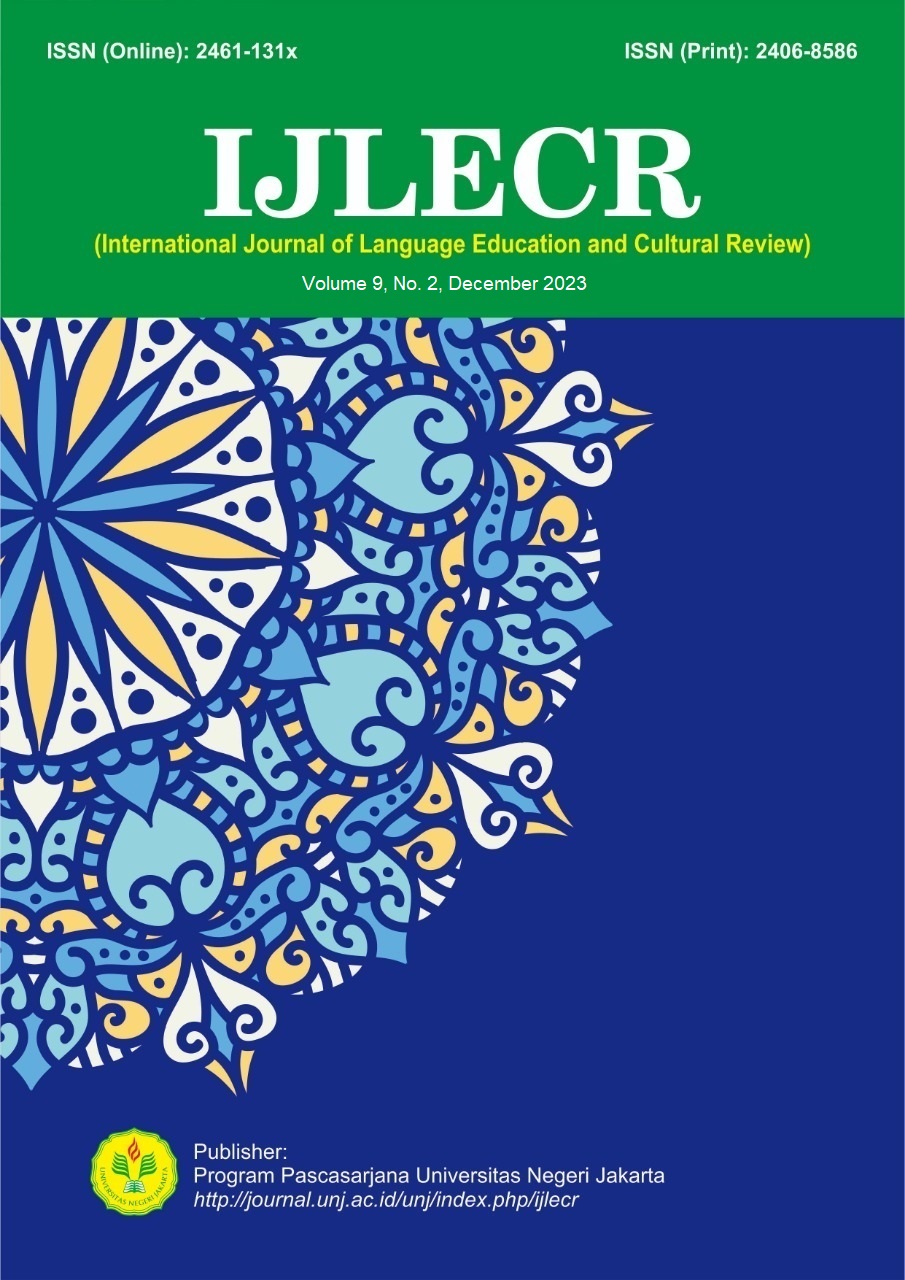The Effectiveness of Case Method to Students’ Paraphrasing Write Skills
DOI:
https://doi.org/10.21009/ijlecr.v9i2.43202Kata Kunci:
Case Method, Paraphrasing Write Skills, Students’, Pre-Experimental DesignsAbstrak
Paraphrasing writing skills are useful for students in writing scientific papers, especially in providing an explanation of a concept using different language from the reference we quote without changing the meaning so as to avoid plagiarism. Writing paraphrases requires critical thinking skills and creativity in processing sentences without changing the meaning. In fact, there are still many students who are not skilled in writing paraphrases. One way to improve students' paraphrasing writing skills is to apply the case method. For this reason, this study aims to determine how much influence the case method has on students' paraphrasing abilities. This research used experimental method with pre-experimental designs. The research design used the One Groups Pretest-Posttest Design. Data collection using paraphrase writing test technique. Analysis of research data by: assessing the results of each student's paraphrasing writing, calculating data normality tests, and conducting hypothesis testing with the Paired Sample T Test using SPSS 23. The results showed that there was a significant effect of the case method on the paraphrasing ability of students of the Management Study Program, Faculty of Economics, Universitas PGRI Palembang. The influence is indicated by the Sig value. (2-tailed) of 0.01 is smaller than 0.05. Students are able to paraphrase using their own language in several techniques, namely changing active sentences to passive ones, shortening sentences, changing sentences to become longer, and replacing words with words that have the same meaning. It's just that there are still some students who paraphrase by only changing some of the words in the quoted sentence by writing the equivalent of the word.
Referensi
Asril, Z. (2014) Microteaching: Disertai dengan pedoman pengalaman lapangan (Microteaching: Accompanied by a field experience guide). Jakarta: Rajawali Pers.
Berbeco, S. (2018). Case method and the Arabic teacher: A practical guide. Bethlehem: Lehigh University Press.
Bridges, E. M. & P. Hallinger. (1999) The use of cases in problem based learning. Journal of Cases in Educational Leadership, 2(2), 1-6. https://doi.org/10.1177/155545899900200201
Choiyeonhee, C. (2012). Paraphrase practices for using sources in l2 academic writing. English Teaching, 67(2), 51–79. doi: 10.15858/engtea.67.2.201207.51
Cox, G. C. (1913). The case method in the study and teaching of ethics. The Journal of Philosophy, Psychology and Scientific Methods, 10(13), 1913, 337–47, https://doi.org/10.2307/2013163
Garvey, T., O’Sullivan, M., & Blake, M. (2000). Multidisciplinary case-based learning for undergraduate students. European Journal of Dental Education, 4(4), 165–168. https://pubmed.ncbi.nlm.nih.gov/11168482/
Gulo, W. (2002), Strategi belajar mengajar (Teaching and learning strategy). Jakarta: PT Grasindo.
Hasanah, Y. A. & Fatimah, S. (2020). Undergraduates’ ability in writing paraphrase and their perceptions of plagiarism”, Proceedings of the 7th International Conference on English Language and Teaching (ICOELT 2019). https://doi.org/10.2991/assehr.k.200306.019
Herreid, C. F. (2007). Start with a story: The case study method of teaching college science. United States: National Science Teachers Association Press.
Hodge, S. R., Murata, N. M., Block, M. E., & Lieberman, L. J. (2003). Introduction: Using the case study method to empower critical thinking. London: Routledge.
Keck, C. (2006). The use of paraphrase in summary writing: A comparison of L1 and L2 writers. Journal of Second Language Writing, 15(4), 261–278, doi: 10.1016/j.jslw.2006.09.006
Kridalaksana, H. (2008). Kamus linguistik (edisi keempat) (Linguistic Dictionary (fourth edition). Jakarta: Gramedia Pustaka Utama.
McNergney, R. F., Ducharme, E. R., & Ducharme M. K. (1999). Educating for democracy: Case-method teaching and learning. New Jersey: L. Erlbaum Associates.
Merseth, K. K. (1991). The early history of case-based instruction: Insights for teacher education today. Journal of Teacher Education, 42(4), 4, 243–249. https://doi.org/10.1177/002248719104200402
Merseth, K. K. (1994). Cases, case methods, and the professional development of educators. Washington: ERIC Clearinghouse on Teaching and Teacher Education Washington DC.
Musiychuk, S. V. (2022). Formation of critical thinking of future service professionals on the basis of the case-method. Общество: Социология, Психология, Педагогика, 11, 155–159. https://doi.org/10.24158/spp.2022.11.23
Noermanzah, N., Wardhana, D. E. C., & Awalludin, A. (2022). Fostering qualitative content analysis skills through case method. English Review: Journal of English Education, 10(2), 689–698. https://doi.org/10.25134/erjee.v10i2.6312
Purdue, OWL. (2020) Paraphrase: Write it in your own words. https://owl.purdue.edu/owl/research_and_citation/using_research/quoting_paraphrasing_and_summarizing/paraphrasing.html
Sakila, S. (2018). Penerapan metode latihan (drill) dalam pembelajaran menulis resensi buku pengetahuan (Application of the drill method in learning to write knowledge book reviews). Sirok Bastra, 6(1), doi: 10.37671/sb.v6i1.119.
Saroh, E. R. S. & Damaianti, V. S. (2017). Pengaruh teknik scramble terhadap kemampuan menentukan ide pokok dan memparafrase dalam pembelajaran membaca pemahaman. EduHumaniora: Jurnal Pendidikan Dasar Kampus Cibiru, 8(2), 144. doi: 10.17509/eh.v8i2.5137
Stake, R. E. (2009). The case study method in social inquiry. New York: American Educational Research Association. https://www.jstor.org/stable/1174340
Thaller, E. A. (1994). Bibliography for the case method: Using case studies in teacher education. http://files.eric.ed.gov/fulltext/ED367610.pdf.
Wasserman, S. (1994). Introduction to case method teaching. New York: Teachers College Press.
Williams, B. (2005). Case based learning-a review of the literature: Is there scope for the educational paradigm in prehospital education? Emergency Medical Journal, 22(1), 577-581. https://www.ncbi.nlm.nih.gov/pmc/articles/PMC1726887/
Yee, S. F. (2018). A phenomenological inquiry into science teachers’ case method learning. Berlin: Springer.
Zaudalova, D.S., Karkina, S.V. & Balwant, S. (2019). Improvement of students critical thinking through the using of the method of case studies. 3C TIC. Cuadernos de desarrollo aplicados a las TIC. Special Issue, October 2019, 152-163. doi: https://doi.org/10.17993/3ctic.2019.83-2.152-163








